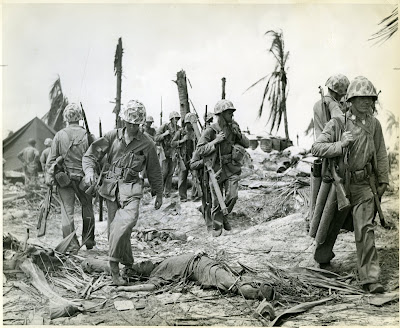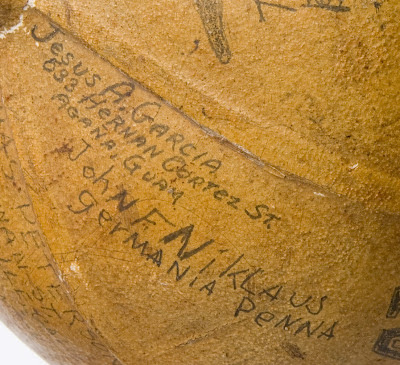Part Two of "A Wake Island Helmet." See part one at:
http://erasgone.blogspot.com/2012/08/a-wake-island-helmet-part-one-dodging.html
With the exception of a handful of
senior military officers and contractors held indoors, the captives remained
three days and two nights on the rocky runway after the surrender.
Leal Henderson Russell of La Grande, Oregon,
wrote in his otherwise optimistic diary: 23 December—". . . Rocks hard,
rain, wind, no cover and few clothes.
Bread and water. Very uncomfortable night." 24 December—"Still
on the rock-pile.
Very hard on the
unclothed men and those who are ill.
Many have dysentery. . . Men hard to control while food and water being
passed out.
Act like wolves. . .
."
 |
| Leal Russell's signature on the sun helmet. Courtesy Glen Binge Family. |
Tensions of the previous days
relaxed a bit on Christmas morning.
One
contractor remembered that they were allowed to retrieve clothing, food, and
tobacco from their dugouts.
Russell recalled that the POWs were allowed
to bury their dead and were fed well for the first time.
They were marched to the north end of Wake
Island and put into the barracks they
had used before the beginning of hostilities.
Several 40-man barracks were packed with 150 men each, but the men had
shelter at last.
He recorded on 27
December: "Japanese treating us with reasonable consideration."
Rodney Kephart, the young carpenter from
Boise remembered: "We slept so well even the screaming of the Japs didn't
disturb us - that was indeed a welcome Christmas present."
 |
| The only known photo taken of US POWs on Wake Island. Notice the white sun helmets. Nat Archives Photo. |
Three weeks after the fall of Wake,
the POWs awoke to see a large vessel, the
Nita Maru, standing off the
southern shore.
She had arrived to
transport the POWs to camps in China. "About 350 including the key men
were selected and were supposed to stay," wrote Russell.
He became the ranking civilian POW when the
Nita
Maru sailed away.
Another of the
Morrison-Knudsen men, recorded in his diary on 12 January, "All but 360 of
the contractors have been sent to Japan today. [He incorrectly assumed the
destination was Japan.] Also the service men except 21 Marines who are too
badly wounded to go."
"You're already identified as dead and
buried!"
Forty-seven year old Glen Binge was
like many other men on Wake. The
promise of well paying work during a bleak economy lured him far from his
Galesburg, Illinois home. It would be almost four years before
he would see his children again. Binge arrived at Wake on October 27, 1941 on a
nine-month contract. He came ashore
with 175 other men from the USS Curtis (AV-4) a seaplane tender,
which shuttled men and equipment between Honolulu and Wake Atoll.
 |
| Pre-War photo of Glen Binge from his local newspaper announcing his capture at Wake Island. |
Sometime after January 12th, Binge
began to have men sign his helmet.
Binge's sun helmet was not unusual.
Hundreds of the white sun helmets were issued by the CPNAB to its Wake
Island men.
The Marines issued similar
sun helmets that were tan and bore the Globe & Anchor emblem on the
front.
There is evidence that many men
recorded names of comrades, or had their mates sign their helmets as mementos,
but the Binge helmet is the only one known to have survived.
It has been a family treasure for sixty
years, but its existence has only been brought to light outside of the family
in the past year.
All of the American names inscribed
are from those men who remained on Wake after the departure of the
Nita Maru.
The 360 contractors who remained were chosen
because of their skills in operating heavy equipment.
They would continue the military build-up of Wake Island with the
same supplies and equipment that they had used for the U.S. Navy.
This time, however, the new architects of
the island defenses were the Japanese.
Logan Kay and Fred Stevens remained
hidden in the scrub brush of Wake Island.
They scavenged for food and moved every few days to avoid the
Japanese.
On March 10th, after living
in the bush for seventy-seven days, the fugitives stumbled upon 56 year-old Ted
Hensel of Burbank, Washington.
"You can't be living men.
You're already identified as dead and buried!" Hensel
retorted.
"You two look
terrible.
Better give yourselves
up.
The Japs won't hurt you.
They're treating us fine."
Hensel persuaded the ragged, starving men to
surrender.
 |
| Ted Hensel drew a map of Wake Island to go with his sigtature. Courtesy Glen Binge Family. |
"A warning to some who still feel that they have
some rights here."
Leal Russell paints a relatively
optimistic picture of his life as a POW.
His keen eyes recorded the daily coming and going of bombers, fighters,
and ships from Wake as well as the weather and day-to-day activity of the
Japanese garrison.
He seemed to be very
interested in his captors and cultivated cordial relationships with some, even
arranging dental work for one of the Japanese with the U.S. contractor doctor.
Russell surely was aware of the
suffering that was going on around him and indeed that he was probably
experiencing himself.
His tone is up
beat in the diary, however, and he refrains from recording adversity except in
extreme cases.
One such case was the execution
of one of his men who had broken into the Japanese canteen and gotten drunk on
stolen alcohol.
On 8 May, Russell
wrote:
After breakfast I found that they had
arrested Babe Hoffmeister who was out of the compound during the night. Okazaki
told me later he had broken into the canteen. . . I also heard he was drunk. It
is apt to go very hard on Babe as he had been repeatedly warned.
Two days later the Japanese gave Hoffmeister a hasty
trial.
He was found guilty, blindfolded
and marched to his grave.
Logan Kay
recorded:
The Japs made Hoffmeister crouch on
his hands and knees. A Jap officer took
his sword, laid the blade on his neck, brought it back like a golf club and
then down on his neck, severing his head with a single blow.
Of the execution Russell wrote:
"May 10th—Julius 'Babe' Hoffmeister was murdered this morning.
Nearly all foremen and dept. superintendents
were called to witness it.
Possibly it
will serve as a warning to some who still feel that they have some rights
here."
The next morning, with Babe's
murder fresh on their minds, the Japanese evacuated 20 Marines and sailors, who
had been recuperating from wounds, from the atoll.
One of these men was PFC Richard L. Reed of South Whitney, Indiana.
Reed was the only Marine to sign Glen
Binge's helmet.
Reed and the other
recovering GIs sailed away on the
Asama Maru, bound for camps in
China.
Only the civilian contractors
remained to toil for the enemy.
 |
| PFC Richard Reed was the only Marine to sign the helmet. Courtesy Glen Binge Family. |
The Japanese did not observe the
Geneva Convention restriction on using POW labor for war-related projects, and
the workers worked at various military projects on all three islands of the
atoll.
Extensive antitank
ditches—protected by slit and communication trenches—were dug on the outer and
inner periphery of all three islands.
Barbed-wire entanglements and land mines provided protection on
potential landing areas.
Inshore from
the narrow beaches, an elaborate system of concrete defenses provided
interlocking fire at almost any point on the atoll.
An estimated 200 concrete and coral pillboxes, bunkers, bomb
proofs, and command posts were constructed with POW labor.
 |
| One of the many Japanese defensive structures still extant on Wake Island. Most were made of captured American Portland cement and built with American POW labor. Photo by Author. |
"Rumors fly but even they grow tiresome."
Only the occasional U.S. bombing
raid or Japanese holiday (when no work was performed) punctuated the monotonous
life of the POWs.
Russell wrote:
"Washington's Birthday on Wake Island and still prisoners of the
Japanese.
No change at all. We work, we
eat, we sleep, and then we get up and do it all over again . . . Rumors fly but
even they grow tiresome."
The
rumors of prisoner evacuation became reality on the last day of September
1942.
Two hundred and sixty five
captives, including Glen Binge and twenty-one of his friends who autographed
his helmet, were loaded aboard The
Tachibana Maru and sent to Yokohama,
Japan.
Ninety-eight Americans were
chosen to stay and to continue their work on construction projects.
Most of the men were jubilant that
they were leaving Wake.
They couldn't
know that their lives as POWs on Wake for the previous nine months had been
relatively easy, and that true hell awaited them.









































